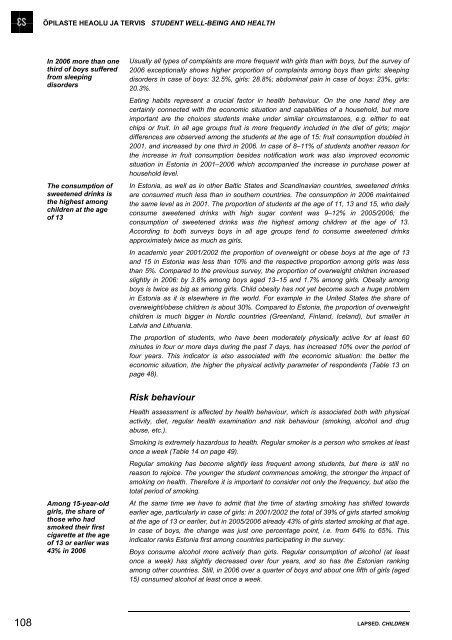LAPSED CHILDREN - Tartu Ãlikool
LAPSED CHILDREN - Tartu Ãlikool
LAPSED CHILDREN - Tartu Ãlikool
- No tags were found...
You also want an ePaper? Increase the reach of your titles
YUMPU automatically turns print PDFs into web optimized ePapers that Google loves.
ÕPILASTE HEAOLU JA TERVIS STUDENT WELL-BEING AND HEALTH<br />
In 2006 more than one<br />
third of boys suffered<br />
from sleeping<br />
disorders<br />
The consumption of<br />
sweetened drinks is<br />
the highest among<br />
children at the age<br />
of 13<br />
Usually all types of complaints are more frequent with girls than with boys, but the survey of<br />
2006 exceptionally shows higher proportion of complaints among boys than girls: sleeping<br />
disorders in case of boys: 32.5%, girls: 28.8%; abdominal pain in case of boys: 23%, girls:<br />
20.3%.<br />
Eating habits represent a crucial factor in health behaviour. On the one hand they are<br />
certainly connected with the economic situation and capabilities of a household, but more<br />
important are the choices students make under similar circumstances, e.g. either to eat<br />
chips or fruit. In all age groups fruit is more frequently included in the diet of girls; major<br />
differences are observed among the students at the age of 15: fruit consumption doubled in<br />
2001, and increased by one third in 2006. In case of 8–11% of students another reason for<br />
the increase in fruit consumption besides notification work was also improved economic<br />
situation in Estonia in 2001–2006 which accompanied the increase in purchase power at<br />
household level.<br />
In Estonia, as well as in other Baltic States and Scandinavian countries, sweetened drinks<br />
are consumed much less than in southern countries. The consumption in 2006 maintained<br />
the same level as in 2001. The proportion of students at the age of 11, 13 and 15, who daily<br />
consume sweetened drinks with high sugar content was 9–12% in 2005/2006; the<br />
consumption of sweetened drinks was the highest among children at the age of 13.<br />
According to both surveys boys in all age groups tend to consume sweetened drinks<br />
approximately twice as much as girls.<br />
In academic year 2001/2002 the proportion of overweight or obese boys at the age of 13<br />
and 15 in Estonia was less than 10% and the respective proportion among girls was less<br />
than 5%. Compared to the previous survey, the proportion of overweight children increased<br />
slightly in 2006: by 3.8% among boys aged 13–15 and 1.7% among girls. Obesity among<br />
boys is twice as big as among girls. Child obesity has not yet become such a huge problem<br />
in Estonia as it is elsewhere in the world. For example in the United States the share of<br />
overweight/obese children is about 30%. Compared to Estonia, the proportion of overweight<br />
children is much bigger in Nordic countries (Greenland, Finland, Iceland), but smaller in<br />
Latvia and Lithuania.<br />
The proportion of students, who have been moderately physically active for at least 60<br />
minutes in four or more days during the past 7 days, has increased 10% over the period of<br />
four years. This indicator is also associated with the economic situation: the better the<br />
economic situation, the higher the physical activity parameter of respondents (Table 13 on<br />
page 48).<br />
Risk behaviour<br />
Among 15-year-old<br />
girls, the share of<br />
those who had<br />
smoked their first<br />
cigarette at the age<br />
of 13 or earlier was<br />
43% in 2006<br />
Health assessment is affected by health behaviour, which is associated both with physical<br />
activity, diet, regular health examination and risk behaviour (smoking, alcohol and drug<br />
abuse, etc.).<br />
Smoking is extremely hazardous to health. Regular smoker is a person who smokes at least<br />
once a week (Table 14 on page 49).<br />
Regular smoking has become slightly less frequent among students, but there is still no<br />
reason to rejoice. The younger the student commences smoking, the stronger the impact of<br />
smoking on health. Therefore it is important to consider not only the frequency, but also the<br />
total period of smoking.<br />
At the same time we have to admit that the time of starting smoking has shifted towards<br />
earlier age, particularly in case of girls: in 2001/2002 the total of 39% of girls started smoking<br />
at the age of 13 or earlier, but in 2005/2006 already 43% of girls started smoking at that age.<br />
In case of boys, the change was just one percentage point, i.e. from 64% to 65%. This<br />
indicator ranks Estonia first among countries participating in the survey.<br />
Boys consume alcohol more actively than girls. Regular consumption of alcohol (at least<br />
once a week) has slightly decreased over four years, and so has the Estonian ranking<br />
among other countries. Still, in 2006 over a quarter of boys and about one fifth of girls (aged<br />
15) consumed alcohol at least once a week.<br />
108<br />
<strong>LAPSED</strong>. <strong>CHILDREN</strong>

















